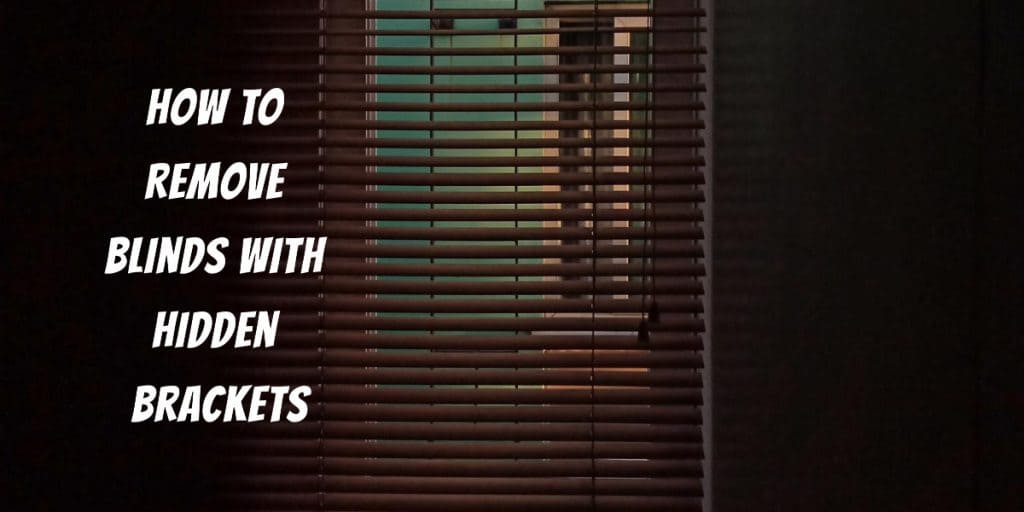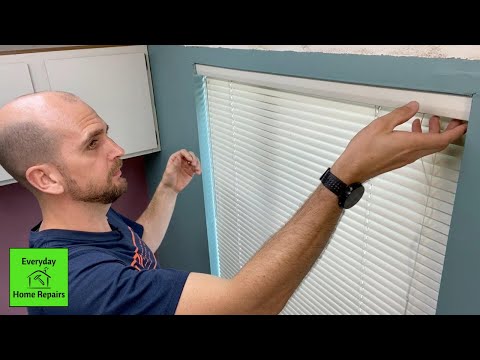
Drape cords were used to hang curtains or drapes from an overhead rail. Today, blinds use slim headrail strips, which serve as points of convergence for the blinds.
Concealed sections fit inside the head rail of the blind, making it invisible to the eye. However, evacuating a blind with covered areas is sensibly simple and should be possible very quickly when supplanting your blinds.
So let us look at how to remove blinds with hidden brackets.
How do you remove blinds with hidden brackets?
Method 1
Just follow the steps written below to remove your blinds with hidden brackets:
Step 1:
First, pull the brace and the bottom rails of the blind as far up to the headrails as you possibly can using the strings. Then, secure the supports and the bottom rails, making the blind easier to remove from the sections.
Step 2:
The blind should be grasped with both hands on either side. You may need to ask for assistance if the blind is more than thirty inches wide so that the blind is lifted evenly and does not become hung up from lifting one end unequally.
Ensure that you grip the head rail across the front and top with your palm and fingers, allowing your thumb to rest underneath the bottom rail of the blind.
Step 3:
Pull the lower part of the blind toward the roof by applying tension on the top and back of the blind with your fingers and palm and the lower part of the blind with your thumbs.
To remove the blind, pull the section from the front end of the headrail up and out of the way.
Step 4:
Unscrew the screws from the hidden brackets with a manual screwdriver or cordless screwdriver with a head bit.
Method 2
Different Types of Blinds with hidden brackets and ways to remove them:

Regardless of whether you’re removing blinds for aesthetic reasons or because they’re blocking sunlight, the first step is clearing the space around your windows.
Remove any shade or draping material, move furniture away from where people sit, and clean up any curtains or blinds if necessary. If anything is hanging above the window at the top of the blinds, remove it.
To remove the valances from your blind, you need to lift the bottom edge of the valances and then gently push them back with a flathead screwdriver until they fall off.
Once the valances are removed, you can access the section that protects the headrail. Depending on the type of blind, the following steps may vary.
Type 1 Venetian and Mini-Blinds:
Blind style is one of the most common types of window coverings. They come in two primary forms: Venetian and small-scale blind.
You can easily remove these blind types from your windows. To do so, draw the blind and tie them down using their lock mechanism or cord.
After opening the brackets securing the blinds’ headrail, you’ll have to squeeze in the springs, flip up the headrail, push out the headrail with a screwdriver, remove the headrail cover, and then slide the headrail out.
Type 2 Vertical Blinds:
First, you must remove the vertical support bars to remove the vertical blinds. You can do this using your fingers or a flathead screwdriver by slightly loosening the screws holding the brackets together and removing them from their holes.
When this is done, remove the blind by either opening up the section and removing the headrail, as one would for Venetian or smaller-sized blind, or – if the headrail is damaged straightaway into the divider or rooftop – unscrew the gadgets with a screwdriver.
Type 3 Cellular and Pleated Blinds:
Flat blinds are easier to install than cellular blinds because they don’t require any special equipment. However, cellular blinds are easier to use than flat blinds because they’re designed to be opened from both sides.
If the blinds are corded, you’ll either need to pull them out of their tracks to remove them or, if they’re cordless, you’ll need to push and tilt them back into place.
Type 4 Roller Blinds:
Roller blinds are not complicated to get rid of. However, they require valences, complicated brackets, and switches.
In addition, both sides of the rollers are different; one has a bracket for the roller, and the other has a swivel that secures the roller.
First, ensure that the blinds are fully retracted. At that point, gently lift out the rollers. Then, remove the mountings by unscrewing them.
Type 5 Horizontal Blinds:
Horizontal blinds can range from wood and faux wood blinds or aluminium mini blinds. Most horizontal blinds have similar mounting brackets. Follow these simple steps to remove the blinds.
First, eliminate the valance if there is one on the blinds. Most valances are mounted with a clasp that will connect at the highest point of the headrail. The valance ordinarily can be removed by lifting off the blinds.
Next, open the brackets. After the valance is removed, you ought to approach the head rail of the blinds and mounting sections. There will be a bracket at each finish of the headrail.
The sections are opened by lifting the entryway or pivoted side of the section. Most sections have a tab that keeps the pivoted side shut. You may need a screwdriver to lift the pivoted side off the tab tenderly.
When the brackets are open, eliminate the window blinds from the brackets. Next, remove the sections from the window outline by removing the sinks holding them.
Method 3
Removing the blinds is extremely simple if the clients follow the correct procedures. The shrouded sections ordinarily are a primary method to hang down the blinds without the apparent equipment appearance.
The concealed compartments are generally fitted inside the visually impaired rail. Without much stretch, the clients can remove the blinds with the shrouded sections at home by following the below-portrayed method.
The materials used for this strategy are hand apparatuses, gather the hand instruments, and start the cycle.
Let’s get started….
Start by opening the blinds to prevent them from getting damaged while detaching them. After that, lift the cord downwards until the blinds get raised upward as much as possible; then, the users need to press it upwards against the metallic bar and the upper cover over the window top.
Now, you need to move towards the brackets that hold up the blinds in their place, and they have to separate the cover set over the blinds.
Additionally, the wide bit of plastic goes over the blind, and if you discover the cover that folds the bit of metal around the blind top, they must follow the following stage.
If, on the off chance that you discover the cover at that place, at that point, they are encouraged to blast it off and afterward lift it upwards inside the bracket surface.
It would help if you were exceptionally cautious while doing this cycle, as though they lift the cover with the power, as it is delicate and can break into numerous little pieces as it can’t deal with the weight.
Also, some surfaces are covered by metal covers, and you need to blast that off by utilizing the level-headed screwdriver.
Usually, various kinds of blinds are available in the market, and there is only one procedure for affixing the blinds at the window top.
First, you must keenly observe the blind tops to find the brackets holding the blinds in place. Sometimes, there can be pieces of metal running at the blind front, each at a distance between the right and left sides of the blind.
These brackets can be found because they hold up the blind curtains and will be fastened at the beginning so they can be seen easily. They are also placed above the area where the blind curtain hangs from the wall and is attached to the top of the windows.
It would be best to utilize the level-headed screwdriver; afterward, they must blast the sections or clasps that typically hold up the visually impaired in one spot.
Next, the clients need to get guaranteed to hold up the blinds while popping the grips if they relax or fall downwards. Again, these clasps ordinarily help keep the blinds in one careful spot.
Once you have popped out the brackets from the frame of the window, they need to hold the blind top with both their hands at their ends.
Then, they need to lift the blinds outwards apart from the window’s frame, and by doing so, you can easily detach the blinds.
If they cannot detach the blinds, they are advised to examine the window top once again to find out the extra brackets that might be placed within the frame of the window and then unhook those brackets by using the flat-headed screwdriver.
In short:
If you need help removing your blinds with hidden brackets, there are a few steps you can take. First, you will need to remove the brackets from the window. Next, you will need to remove the blinds from the bracket. Finally, you will need to reattach the blinds to the bracket.
- Read more: Hacks For Curtains That Are Too Long.


